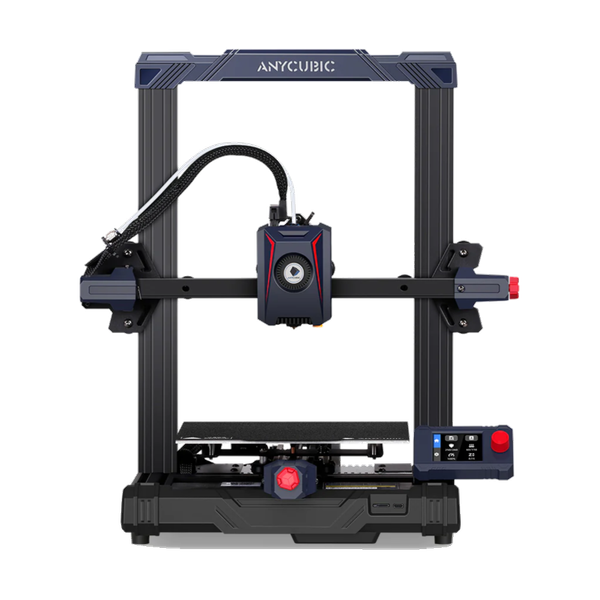If you make a purchase using a shopping link on our site, we may earn a commission. Learn More
Comparing the Anycubic Kobra 2 Neo and Bambu Lab A1 Mini

Anycubic Kobra 2 Neo
(~8.75 x 8.75 x 10 in)
Vs.

Bambu Lab A1 Mini
(~7.25 x 7.25 x 7.25 in)
About the Anycubic Kobra 2 Neo
The Anycubic Kobra 2 Neo is an entry-level 3D printer that offers a range of premium features at an affordable price point. One notable feature is the automatic bed leveling (ABL) system, which ensures perfect first layers and reduces issues with bed adhesion. The ABL system measures and compensates for any inconsistencies in the print bed, allowing for better tolerances even on slightly warped beds. This eliminates the need for manual bed leveling, saving time and effort. Another standout feature of the Kobra 2 Neo is its direct-drive extruder. Unlike side-mounted bowden extruders, the direct-drive extruder is mounted right above the hot end, pushing the filament directly into it. This design reduces the chances of filament jamming and requires less maintenance. It also makes the printer compatible with flexible materials, offering more versatility in printing options. The Kobra 2 Neo comes with a PEI Spring Steel bed, which is a premium build surface option. The PEI bed provides excellent first layer adhesion without the need for additional treatments. It can be flexed to quickly remove printed parts, making the printing process more efficient. However, it is important to regularly clean the bed with a solvent like acetone or IPA to maintain its adhesion. One drawback of the Anycubic Kobra 2 Neo is the limited online community support. With a smaller community, users may need to rely more on their own troubleshooting and problem-solving skills. Additionally, the printer does not have a touch screen interface, which may be seen as a convenience for navigating through the settings and files during the printing process. Overall, the Anycubic Kobra 2 Neo is a competitive entry-level 3D printer that offers high-speed printing, automatic bed leveling, and a direct-drive extruder. Its premium features and affordable price make it an attractive option for beginners and enthusiasts alike. However, potential buyers should consider the limited online community support and the absence of a touch screen interface.
About the Bambu Lab A1 Mini
The Bambu Lab A1 Mini is an entry-level 3D printer with advanced sensors and printing features that are typically only found on machines in higher price tiers. Its build volume of 180 x 180 x 180 mm (7.1" x 7.1" x 7.1") is smaller than average, and the single Z column design doesn't offer the same physical stability of the standard 2-column or enclosed frame designs found on many other printers. However, the calibration and monitoring features of the A1 Mini may make up for these shortcomings. The A1 Mini includes a direct drive extruder with an all-metal hot end that can heat up to 300°C, allowing it to print most standard filament types, including flexible filament. However, the PEI build plate can only heat up to 80°C, which will limit the printer's ability to print certain materials such as ABS. The Bambu Lab A1 Mini includes advanced firmware features such as vibration compensation and pressure advance, improving print quality. The A1 Mini also includes automatic bed leveling and Z offset calibration to simplify the calibration process. A new flow rate sensor in the hot end allows it to calibrate the flow rate of the filament to further improve printing performance. Similar to other Bambu Lab printers, the A1 Mini includes WiFi connectivity, allowing users to monitor and control the printer with the Bambu Studio computer application or the Bambu Handy smartphone app. A camera mounted in the Z gantry allows for remote monitoring of prints. Our take on the Bambu Lab A1 Mini is that its unconventional design and small build volume may be hard for some users to accept, but the advanced printing features make it worth considering as an entry-level machine. The A1 Mini is more expensive than other entry-level 3D printers, and can't print items as large as some of those machines, but its sensors and firmware features should make it capable of producing higher-quality prints.
Click here to view the Anycubic Kobra 2 Neo on Amazon.
Click here to view the Bambu Lab A1 Mini on the Bambu Lab website.
You can find a side-by-side comparison of the specifications for these two printers in the table below:
Details & Specifications
Anycubic Kobra 2 Neo
Bambu Lab A1 Mini
General
Extruder & Hot-end
Physical Characteristics
Usability
Electronics
Where to Buy
Brands Overview
Anycubic
Anycubic is a budget line of Creality Ender 3-like clones, known for offering more features than Creality printers but at lower prices. Founded in 2015, Anycubic is currently focusing on their Kobra series printers with a variety of ease-of-use features and attractive pricing.
Bambu Lab
Bambu Lab, based in Shenzhen, China, and founded by five ex-DJI engineers, has made notable strides in the 3D printing arena with their unique combination of innovation and user-friendly interfaces. They launched their journey with a successful Kickstarter campaign in 2022, securing over $7 million in funding. Their printer lineup, from the flagship Bambu X1-Carbon to the more affordable Bambu P1P, showcases their commitment to high-performance features while ensuring ease of use, making them a rising competitor in the 3D printing industry.